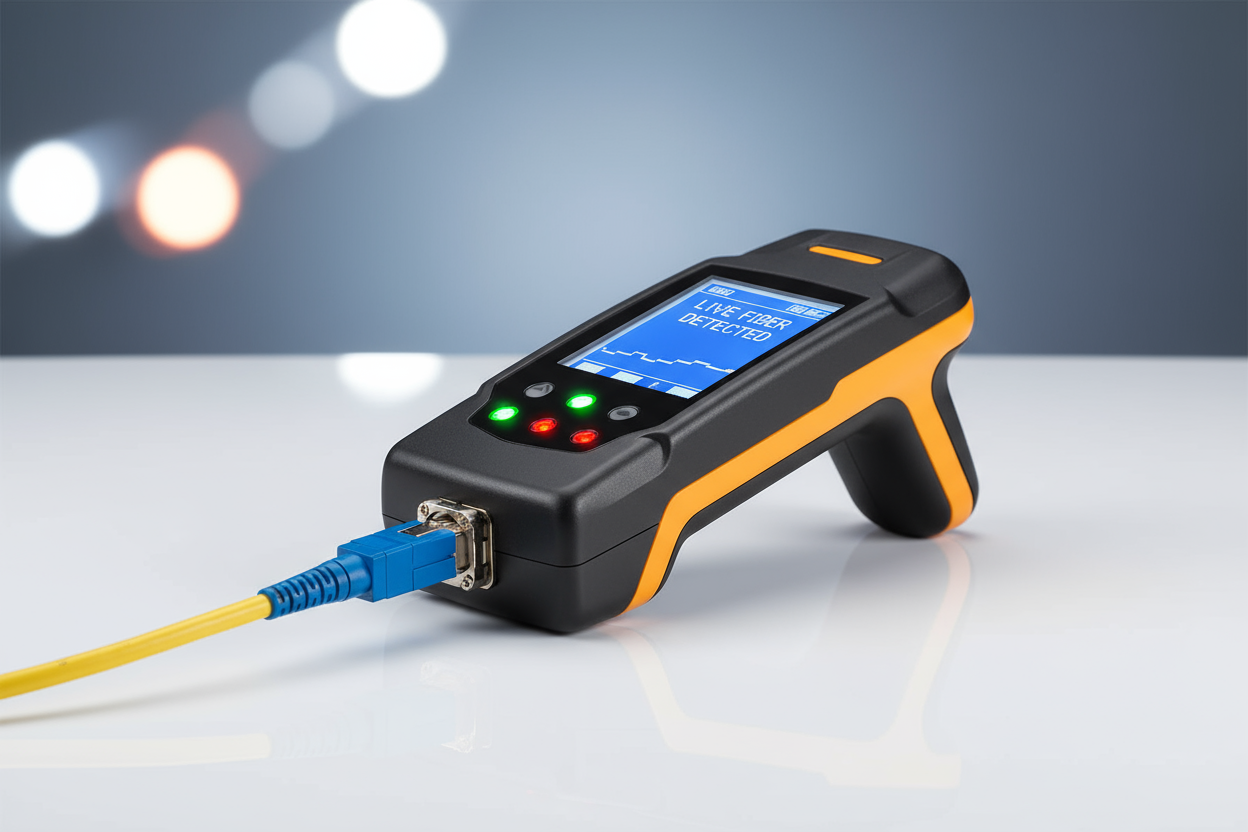
Live Fiber Identification: How to Avoid Accidental Disruption
Live Fiber Identification: How to Avoid Accidental Disruption
In modern fiber optic networks, uptime is everything. Whether supporting enterprise connections, telecom infrastructure, or data center operations, even brief service interruptions can cause significant losses. Yet one of the most common—and avoidable—causes of downtime occurs when technicians accidentally disconnect or disturb active fibers during maintenance.
That’s where Live Fiber Identifiers (LFIs) come in. These compact, handheld tools allow technicians to safely detect active fibers without disconnecting or damaging them, ensuring uninterrupted service and confident field operations.
What Is a Live Fiber Identifier?
A Live Fiber Identifier is a non-intrusive test instrument designed to detect light signals in a fiber without breaking the connection. It gently bends the fiber to sense optical power—whether the signal is continuous (CW) or modulated (like a 270 Hz or 1 kHz tone).
Unlike visual fault locators or power meters, which require direct access to the fiber end, LFIs test through the fiber jacket. This makes them indispensable during live network maintenance, fault isolation, or when identifying fibers in large bundles.
How Live Fiber Identifiers Work
LFIs use a precision clamp mechanism that lightly bends the fiber just enough for a small amount of light to escape the core. Internal photodetectors analyze that light to determine:
-
Whether the fiber is live or dark
-
The direction of signal transmission
-
The modulation tone frequency, if present
This non-destructive method ensures fibers stay intact and service continuity is maintained throughout testing.
Why Live Fiber Identification Matters
1. Avoiding Accidental Disruptions
When technicians perform work in crowded splice enclosures or patch panels, identifying the correct fiber is crucial. An LFI allows verification without disconnecting live links, preventing costly service interruptions.
2. Improving Safety and Efficiency
Working with live fibers can pose laser safety risks. LFIs reduce exposure to active signals by eliminating the need to view or handle open connectors.
3. Simplifying Maintenance and Troubleshooting
During network upgrades, technicians can quickly check which fibers are active before re-routing, splicing, or testing. LFIs make it easier to manage multi-fiber networks efficiently.
4. Supporting Tone Detection for Fiber Tracing
When used alongside a modulated light source, LFIs can trace fibers end-to-end, helping teams match fibers across distribution points or patch panels.
Common Use Cases for Live Fiber Identifiers
-
Field Maintenance: Identify active fibers during repairs or relocations without service downtime.
-
Installation Validation: Check for live traffic before performing splicing or termination.
-
Network Audits: Map and label fibers accurately in complex infrastructure.
-
Data Centers: Trace fiber paths across densely packed panels.
-
Telecom Operations: Detect and isolate active fibers in backbone networks.
Complementary Tools: Visual Fault Locators and Loss Testers
While LFIs provide live detection, other tools can enhance accuracy and troubleshooting:
-
Visual Fault Locators (VFLs): Great for quick fault identification on dark fibers.
-
Loss Testers and Power Meters: Measure signal loss and verify optical performance after confirming the fiber is inactive.
Combining these tools creates a complete, safe workflow for fiber installation and maintenance.
Best Practices for Using Live Fiber Identifiers
-
Always ensure the correct fiber type and diameter setting before clamping.
-
Avoid excessive bending or tension on the fiber during use.
-
Calibrate your device periodically for consistent accuracy.
-
Use with a compatible light source when tracing or labeling fibers.
-
Record fiber status data when performing maintenance for traceability.
Shop Live Fiber Identifiers at TT Instruments
At TT Instruments, we offer a professional range of Live Fiber Identifiers designed for telecom, data center, and field applications. Each device provides accurate signal detection, directional analysis, and tone recognition to ensure safe and efficient network operations.
You’ll also find complementary tools in our Fiber Optics collection, including Visual Fault Locators, Loss Testers, and Optical Power Meters—everything you need for comprehensive fiber management and maintenance.
Keeping Networks Live and Protected
Accidental fiber disruption is one of the simplest mistakes to prevent—and one of the most expensive to fix. With a Live Fiber Identifier in your toolkit, you can confidently maintain, trace, and test active fibers without risking downtime. In the world of high-speed connectivity, precision and caution go hand in hand.
FAQs
1. What is a Live Fiber Identifier?
A Live Fiber Identifier detects optical signals in a fiber without disconnecting it. It senses light through a gentle bend, confirming whether a fiber is active or dark.
2. Can I use a Live Fiber Identifier on any fiber type?
Most LFIs are compatible with both single-mode and multimode fibers, though calibration may vary depending on diameter and jacket thickness.
3. Does using an LFI interrupt the signal?
No. LFIs use a non-intrusive detection method that doesn’t disturb transmission, making them safe for use on live systems.
4. What’s the difference between an LFI and a Visual Fault Locator?
An LFI identifies live fibers without disconnecting them, while a Visual Fault Locator (VFL) is used to visually locate faults or breaks on inactive fibers.
5. Why are LFIs essential for technicians?
They help technicians avoid accidental disconnections, ensure safety, and maintain network uptime during testing or maintenance work.


